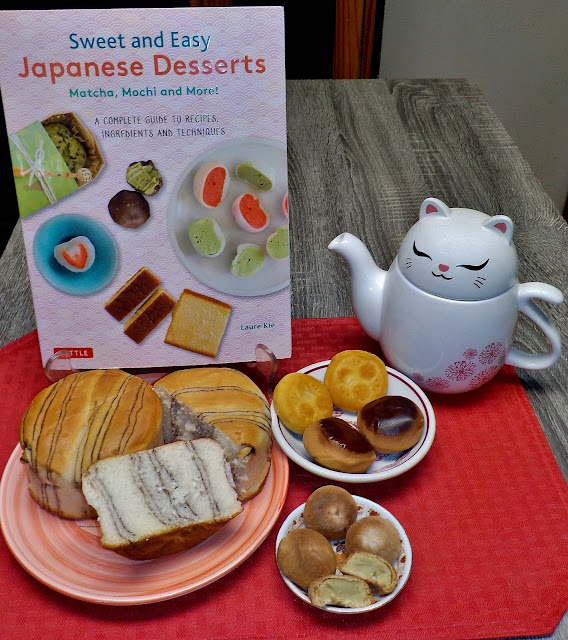It has been a long while since I have attempted a book review of any type. Usually, if interested in a book of any genre, I will read the reviews already written. Depending on the amount, most either regurgitate reviews from the back of the book, or simply say, “I liked it.”, or “I did not like, or even finish it.” Typically, depending on my own personal conclusion, it will get one to five stars on Goodreads or Amazon as I have nothing new to add to the many reviews already written.
So, bear with me as I review Sweet and Easy Japanese Desserts by Laure Kie. In past articles I have written often of Japanese foods, and a sweet treat named mochi. This baking book gives step by step instructions to create, not only mochi, but matcha, sweet buns, the doughs to create these, and delicate cakes that melt in the mouth. The photography is clear and detailed, with many recipes depicted in step-by-step photos.
When looking for a baking book related to Japan, I found that many used measurements in the metric system only. In this book, both systems of metric and imperial are given in each recipe, and there are conversion charts in the back pages. For those of us who know the term “metric”, but not “imperial”; the International System of Units or SI (the modern form of the metric system), the British imperial system, and a third one popped up in my research, American “customary”, but it looks the same as “imperial”.
In the beginning, there are sections on fillings, flours, utensils and even how to wrap the desserts for gifting. When it comes to fillings, red bean paste and green tea matcha are popular names you might have heard. Since we live here in the southwest, and read “red bean”, you might automatically presume it is the same type of beans we have in this area, namely kidney or pinto. The Japanese use a red bean named adzuki, aka red mung bean, which primarily grows in Asian countries. The dried beans are soaked in water for twelve hours, drained and covered in fresh cold water, then boiled for two hours until very soft. The beans are cooled and crushed into a paste; smooth or chunky depending on the dessert that is to be created.
Now many of us have used dried beans to create soups, stews or side dishes using the soak, drain and cook method, but on desserts? The bean paste is combined with sugar; oh, yellow mung beans and white beans, called shirohana can be used for paste making also. Do not fret, if the authentic Asian varieties cannot be found, local varieties of your area work just as well. Yes, but how does sweetened bean paste taste? Personally speaking, it was unusual at first; a unique flavor that kept getting better, especially combined with whatever outer layer contained it. That is where the different flours come in, and whether a cookie, cake, or bun have been created.
Now this is supposed to be a book review, but here I am going on about making bean paste. Guess what, I believe the review is working out well, as I am showing you how excited the descriptions and photos can make the reader. Basically, if I was showing you the book, in person, it would be, “Look, look at this photo, I want to eat some of that right now!”, “Oh, and look at the recipe, that is so easy!”. In essence, whether a novel or a cookbook, if it gets the reader excited, it must be doing something right.
…and here I go again with some excitement, I just found the recipe, page 84, for Japanese Cheesecake. This cheesecake is not the typical dense variety that has to cool overnight, and you hope the top does not crack. It is a light, airy, sponge-like variety obtained by mixing in whipped egg whites, and is also called "jiggly cake" due to its tendency to wobble or jiggle when touched. It is not super sweet and simply melts in the mouth; great accompaniments are whipped cream and fresh fruit on the side. For those of you who might be Pokémon fans, the character Jigglypuff is not named after this cheesecake. His name, in Japanese, is actually Purin which translated to custard pudding; still a dessert, but not cheesecake.
Recipe sharing in this article? Oh no, instead, if you are truly curious and want to delve into the realm of Japanese baking, buy this book. Careful though, you may become so addicted to all the new sweets and treats, that your usual snickerdoodles will not taste as good any longer.
Mary Cokenour
